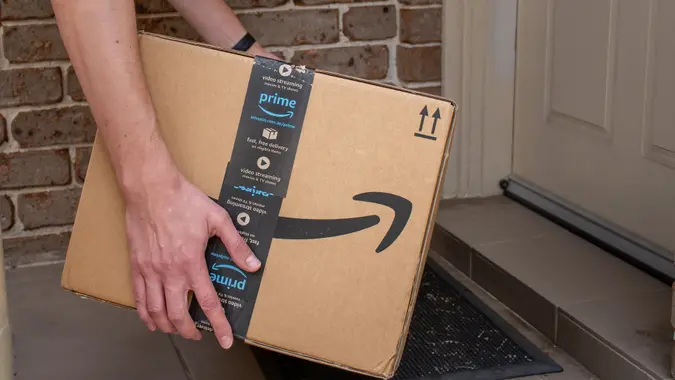Are Federal Stimulus Checks or State Rebate Checks Better for Your Wallet?

Commitment to Our Readers
GOBankingRates' editorial team is committed to bringing you unbiased reviews and information. We use data-driven methodologies to evaluate financial products and services - our reviews and ratings are not influenced by advertisers. You can read more about our editorial guidelines and our products and services review methodology.

20 Years
Helping You Live Richer

Reviewed
by Experts

Trusted by
Millions of Readers
In general, federal stimulus programs typically offer higher payment amounts, while state rebates will pay state residents based on excess tax revenue or relief programs.
The best part is you can get both a federal stimulus check and state rebate check, depending on eligibility. We’ll break down what federal stimulus checks and state rebates are, how much you might be able to get and the pros and cons of stimulus overall.
What Are Federal Stimulus Checks?
Stimulus checks are money sent by federal or state governments to help “stimulate” the economy. The idea is to send money to Americans in hope of helping with financial needs, and to enable spending to boost the economy.
Stimulus checks are usually only sent during times of national or local crises. The latest round of federal stimulus checks went out in 2020 and early 2021 during the pandemic. Households receive thousands of dollars, qualifying for up to $3,200 per adult and $2,500 per child over three rounds of payments.
In addition to federal stimulus checks, some states offer rebate checks or “inflation relief” payments when they run surplus revenue or wish to help with the higher cost of living. These state rebates are similar to federal stimulus checks, but differ in scale, timing, eligibility and impact.
What Are State Rebate Checks?
State rebate checks are one-time payments issued by individual states rather than the federal government. They typically come from budget surpluses, excess tax revenue or specific relief programs designed to offset higher living costs or inflation.
Unlike federal stimulus checks, (which aim to stimulate the entire national economy during a crisis) state rebates focus on local conditions. For example, if a state has a large budget surplus, it might return money directly to taxpayers. Other programs might target lower-income residents or families with dependents to provide financial relief.
Some states automatically issue rebates to all taxpayers who filed returns, while others require applications or restrict payments to certain income levels. It’s important to review eligibility for your state’s rebate programs so you know how much you can expect to receive (if anything).
Benefits of Stimulus Checks
Simulus checks help citizens in times of need. Here are a few benefits of sending them out:
- Immediate financial relief: Checks help families cover essentials like rent, food and bills when incomes drop. For many, it is an instant safety net to help stay afloat during a crisis.
- Boosts consumer spending: More cash in circulation means higher spending, which supports local businesses and jobs. Economists call this the “multiplier effect.”
- Helps low-income households most: Lower-income families are less insulated from austerity, and stimulus checks can help them keep food on the table and rents paid if income dries up.
- Reduces financial stress: Research from the University of Michigan found that stimulus checks lowered missed debt payments, improved food security and eased money anxiety for millions.
- Flexible use: Unlike targeted programs for specific communities, stimulus checks let recipients decide how to use the money.
Drawbacks of Stimulus Checks
Stimulus checks sound like a great idea — who doesn’t love free money? But there are some significant drawbacks to consider:
- Increases inflation: Stimulus checks usually come from the Federal Reserve “printing money” and increasing the overall money supply. This can push prices of consumer goods higher when supply is limited, which we saw in 2022 after the pandemic-related stimulus checks were sent out.
- Increases national debt: Federal stimulus programs are often financed by government borrowing, which increases the overall national debt balance.
- Payments become expected: Once people get used to government payments, it becomes public expectation that the government will send checks whenever there is a national crisis.
- Wasted on high-income households: Many high-income households receive checks they don’t need, which unnecessarily increases government spending and national debts.
Are New Stimulus Checks Coming?
Contrary to the rumor circulating online — and words from President Trump’s own social media accounts — there are no scheduled federal stimulus checks as of November 2025.
According to Newsweek, Trump has repeatedly mentioned that the White House was thinking of sending tariff rebate checks due to what he claims is increased government income from his international tariff policy. But nothing has come of this other than a proposal from Sen. Josh Hawley to send $600 to American families for every adult and child.
In the proposal, dubbed the American Worker Rebate Act, Sen. Hawley proposes that the $600 checks would be reduced by 5% for joint filers with an adjusted gross income above $150,000 or single filers earning more than $75,000 individually.
So far, the bill hasn’t been voted on, and no checks are scheduled to come in 2025.
What About State Rebate Checks?
Several states are currently providing rebates or inflation-relief payments in 2025. These states are issuing checks or refunds based on surplus tax revenue or budget windfalls.
Here are a few states that might be sending you money:
- Colorado’s TABOR refunds (triggered when state revenues exceed constitutional limits) will issue refunds up to $1,130 in some cases, according to Soy Aire.
- Virginia is issuing one-time fall rebates of up to $400 to eligible taxpayers.
- New York’s 2025 “inflation refund” checks have begun to go out to millions of residents, with amounts up to $400 for joint filers under certain income thresholds.
These state programs differ widely in eligibility, timing and magnitude. It’s important to review your state rebate programs to see if you’re eligible.
Which Is Better, Federal Stimulus or State Rebate?
If the $2,000 stimulus ever happens, it will be greater than the state rebates currently on offer, and exceed any (though not the sum of) of the federal government’s three Economic Impact Payments sent out during the pandemic’s peak, which were $1,200, $600 and $1,400 across 2020 and 2021. However, without any clear evidence it will occur, the state rebates are, at present, the best hope for economic relief for taxpayers.
More From GOBankingRates
 Written by
Written by  Edited by
Edited by 

























